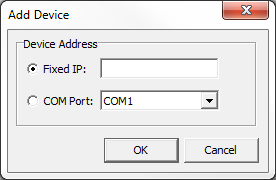Table of Contents
Logging Menu
Add Device
Use the Add Device command to manually set up a connection to a DSP Core. This is necessary if the device is either connected to your PC via a serial port (only RM4200D devices) or if it can not connect using UDP broadcasts.

To set up a connection to the device you can use:
- Fixed IP - You can enter the IP address of a device in the
Fixed IPbox. This is useful if the PC with the DHD Communication Server and the DSP core can not communicate using the UDP protocol, but the IP address of the device is known. - COM Port - Select this option if you want to connect an RM4200D device to the PC using the serial port. Select the correct port from the list. Make sure that this port is not used by other programs. Series 52 devices can not be connected via serial connection.
Click OK to confirm the settings. The device you just added is shown in the in the DHDCS device list.
Note
If you have added a device to the list manually, from this moment on, it is available to all DHD applications able to access the DHDCS.
Remove Device
Use this command to remove a device from the device list, if you have added it before using the Add Device command. Select the device in the device list and then select the command Remove Device from the Logging menu. Alternatively, right-click on the device in the device list and then click Remove Device.
Tip
You should remove a device from the list if it is connected via a serial port and if the UDP communication between the device and the PC is working again. In this case, the device connects automatically and then it appears in the list twice. Remove the device that was added manually to the serial port. Now, data will be transferred using the faster Ethernet port.
If you want to disconnect a serial connection between a RM4200D device and the PC, first remove the device from the device list before disconnecting the cable! If not, this can cause error messages when interrupting the connection. For Series52 Devices this step is not required.
Freeze Log Window
Sometimes it can happen that a lot of messages are shown in the logging area of the DHD Communication Server within a short period of time. The amount of incoming messages depends on how many devices are monitored and what kind of messages are included into the logging. If the window is scrolling very fast, you can stop showing new messages by clicking the Freeze Log Window command. Alternatively, you can press F5 on your keyboard. You can also click this command again to continue showing the messages. After restarting the messages, you can see the number of skipped messages in the logging area.
Note
If you have configured in the options that the messages are recorded in a log file, the recording continues even if the shown messages are stopped.
Clear Log Window
Use the Clear Log Window command to delete the content of the logging area. An output of the messages into a log file is not influenced by this.
Show Log File
The Show Log File command opens the log file in the default editor of the PC.
Options
See Logging Options Page.